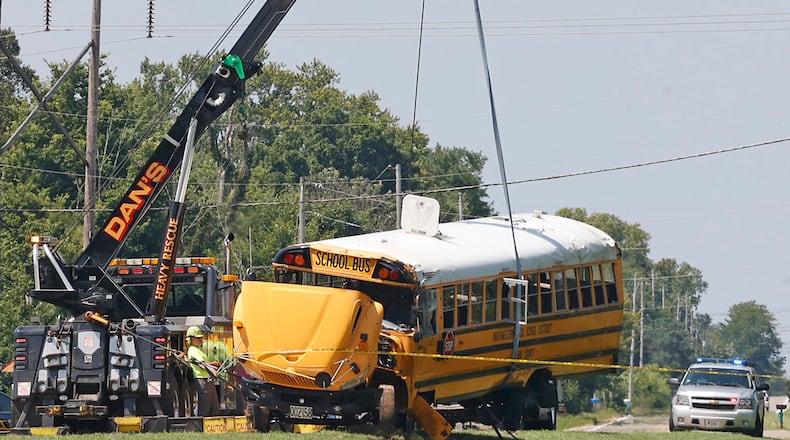School buses are already among the safest vehicles on the road, with less than 1% of all traffic fatalities involving children on school transportation vehicles, according to the National Highway Traffic Safety Administration.
“They are the safest mode of transportation, particularly for kids going to school, just based upon the low number of fatalities for occupants on school buses,” said Rob Molloy, director of the Office of Highway Safety at the National Transportation Safety Board, which investigates accidents.
Nationally, there were 113 occupants killed in school transportation vehicles from 2012 to 2021, according to the National Highway Traffic Safety Administration. Of those victims, 52 were drivers and 61 were passengers. Most (70%) of the people killed in school-transportation-related crashes were occupants of other vehicles involved in the crashes.
Only nine states require seat belts on school buses, and Ohio is not one of them. Many safety organizations, like the National Transportation Safety Board, and parent groups, like the Ohio and National PTA boards, recommend use of seat belts on school buses.
“National Safety Council calls for all school buses to have seat belts on them,” said Jane Terry, vice president of government affairs for NSC, a nonprofit promoting health and safety. “We’ve known for years seat belts save lives, and while school buses are very safe, we can always make them safer. And from our perspective that’s what we should do. Safety can’t rest.”
School buses also have to meet industry standards, Molloy said, in terms of the strength of the vehicle.
“They are large vehicles. They have standards with regard to the roof strength, the side strength, the windows, all of which are, again, designed to protect those inside,” Molloy said.
Terry said the size and color of school buses makes them stand out on the road.
School buses are also designed with compartmentalization of the interior in mind, with the padding on the seats protecting the occupants on the bus should front or rear-impact accidents occur. The high backing of the seats also help keep the occupants in their area, Molloy said.
“When school buses were developing compartmentalization, seat belt usage was really low in the United States, and so this was a way of providing protection, particularly in a frontal crash,” Molloy said.
What compartmentalization doesn’t help with, though, are accidents where buses are struck from the side or accidents where buses roll. The force of the impact moves the occupants in a different direction. That’s where seat belts come more into play.
“In those situations, they’re not getting caught by the seat in front of them, and there’s the higher risk for injury or potentially ejection on rollovers,” Molloy said.
Credit: DaytonDailyNews
Arguments against bus seat belts have included cost, the existing low injury rate, effectiveness/fit given variation in size of children on the bus, and extra staff required to help younger children get their seat belts attached properly.
“Generally, I think it’s a cost consideration,” said School Bus Safety Alliance founder Rudy Breglia, of northeast Ohio. Breglia formed his group after a 2016 school bus rollover crash killed six children in Chattanooga, Tenn.
Seat belts increase the cost of the school bus by about 8%, Breglia said.
“But if you go over the lifetime of the bus, it winds up costing about $5 per student per year or three cents a day per student over a year to have seat belts in the bus installed,” Breglia said.
There is also the thought that an occupant could get stuck in their seat in an accident, but Molloy said that is reasoning is anecdotal.
“I don’t think there’s any data to support those. Those are more just kind of conjecture, so the reality is there aren’t negatives,” Molloy said. “Another that people will bring up, too, is that it might adjust the number of people who can be on the bus so less people can be transported, but we haven’t seen that either in places that have required seat belts.”
Advocates have also pushed school districts to make the choice themselves. The Beachwood school district near Cleveland requires seat belts on school buses, and Avon Lake, where Breglia lives, has purchased school buses with seat belts in the past.
“For more than 55 years, we’ve known the benefits of seat belts,” Breglia said.
Credit: Bill Lackey
Credit: Bill Lackey
By the numbers
From 2012 to 2021, there were 998 fatal school-transportation-related crashes, and 1,110 people of all ages were killed in those crashes — an average of 111 fatalities per year, the National Highway Traffic Safety Administration found.
• But of those 1,110 deaths, only 113 of them were people riding in school transportation vehicles (52 drivers, 61 passengers). Most of the people killed in school-transportation-related crashes were occupants of other vehicles involved in the crashes.
• Impacts to the fronts of school transportation vehicles were involved in the most occupant fatalities from 2012 to 2021.
• From 2012 to 2021, there were 206 school-age children who died in school-transportation-related crashes; 42 were occupants of school transportation vehicles, 80 were occupants of other vehicles, 78 were pedestrians, 5 were cyclists, and 1 was an “other” nonoccupant.
• Over half (53%) of the school-age pedestrians killed in school-transportation-related crashes from 2012 to 2021 were 5 to 10 years old.
• More school-age pedestrians were killed from 6 a.m. to 6:59 a.m. than any other hours of the day from 2012 to 2021.
• From 2012 to 2021 of all school-age pedestrians killed in school transportation-related crashes, almost one-fifth (19%) were struck by school transportation vehicles that were going straight.
About the Author



